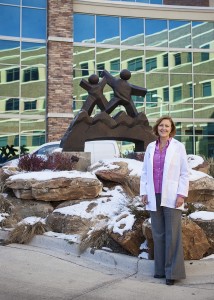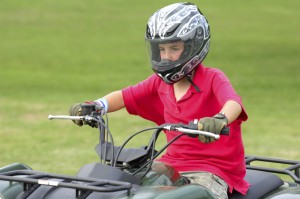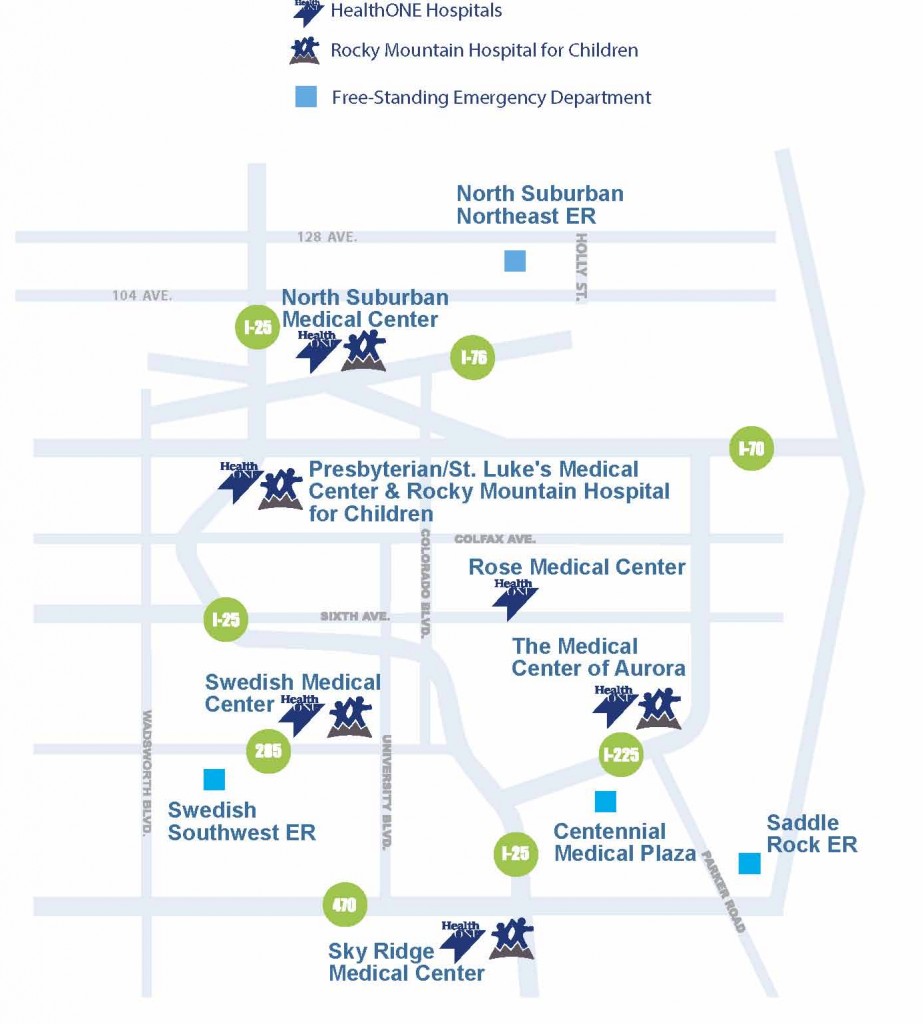Pediatric Perils | by

Trauma experts offer tips on preventing serious childhood injuries
With the things Dr. Christine Darr sees daily, it’s a wonder her own kids are ever allowed out of her sight. Whether it’s a ruptured organ from a pre-schooler’s spill off a slide, a cracked skull from a toddler’s tumble out a three-story window, or a mangled ankle from a child’s bounce off a trampoline, the HealthONE emergency pediatric specialist knows what hurts children: accidents.
Accidents kill more children every year than any other cause — and most of the injuries are preventable. In hopes of reducing those numbers, Darr and Tracey Holmberg, HealthONE’s pediatric injury prevention coordinator, offer a snapshot of some top childhood traumas below. Darr provides an “Inside Look,” while Holmberg gives prevention “Top Tips.”
FALLS
U.S. Fast Stat: Falls top the list of nonfatal injuries for children and teens, generating about 8,000 emergency visits a day (Centers for Disease Control and Prevention).
Inside Look: Windows are a prime hazard, particularly now, as the weather grows warmer, Darr says. “Often they are open in the summer with just a screen, but screens don’t support the weight of a child.” Balconies, decks, shopping carts and stairs are other main culprits. “And we see a lot of kids with injuries from playground equipment, especially the monkey bars and slides.” Head injuries are often the most severe injury from falls, followed by internal injuries and broken bones. “I had a 3-year-old patient who had fallen from a slide. The child seemed fine and was talking and sitting up, but I noticed grunting, a sign of abdominal pain in kids.” The result: a lacerated spleen.
Top Tips: Install window guards and stops and keep furniture away from windows. Use low shopping-cart attachments for kids and safety belts. Use safety gates at top and bottom of stairways.
 POISONINGS
POISONINGS
U.S. Fast Stat: More than 300 children through age 19 are seen in an ER for poisoning each day, generally from household chemicals or drugs (CDC).
Inside Look: Teens overdosing on highly accessible synthetic marijuana or today’s potent doses of the real drug, particularly when ingested in edible form, is becoming an increasingly common emergency event, Darr says. “Part of the problem is when they are eating it rather than smoking it, it can take longer to feel the effect. So they eat more and more.” For her little patients, accidental ingestion of pot or other prescription drugs left accessible is also a problem. Generally, these smaller accidental ingestions of marijuana cause sleepiness and vomiting. But overdosing with teens that have ingested large quantities can result in coma and seizures.
Top Tips: Store drugs and household products out of sight and reach of children. Teach children to ask before they eat something. Post the poison-control number (800-222-1222) near the phone.
INGESTIONS
U.S. Fast Stat: Emergency cases of children ingesting magnets increased five-fold between 2002 and 2011 (Annals of Emergency Medicine).
Inside Look: Suffocation has always been a chief concern for infants and toddlers, who tend to put everything in their mouths. Now magnetic toys and smaller batteries (such as the tiny round ones in remotes and watches) are adding new threats. “Swallowed pennies and dimes generally just pass through the child,” Darr says. But batteries can burn holes in the esophagus or intestine. “And with those tiny, round toy magnets, if two or more are swallowed, they can end up getting stuck to each other on either side of a fold of intestine, eventually cutting off blood supply and creating a hole.” Both scenarios are potentially deadly emergencies requiring surgery.
Top Tips: Learn the Heimlich maneuver. Do not induce vomiting. Keep battery-controlled devices out of reach of children or place duct tape over battery compartment. Seek immediate care if you suspect magnet/battery ingestion.
 RECREATION/SPORTS
RECREATION/SPORTS
U.S. Fast Stat: In 2011, there were about 29,000 ATV-related ER-treated injuries in children under 16 (Consumer Product Safety Commission).
Inside Look: Trampoline and ATV injuries are so prevalent, and sometimes so severe, that the AAP has long advised against their use for kids. “Trampolines become more of a problem when multiple people jump on them, especially parents who outweigh the child,” Darr says. “I had one patient who had a serious ankle fracture after the dad jumped on a trampoline, propelling the patient off and onto the ground.” A lack of safety gear is a major problem with backcountry ATV users. Concussions are also common youth injuries, with football, ATV’s, skateboarding and bicycling all notable causes.
Top Tips: Always ensure children are wearing protective clothing and proper equipment, whether they are playing a sport or riding a bike. In particular: Wear the proper helmet for the activity.
Did you know?
- A child ends up in a U.S. emergency room every 22 minutes because of a shopping-cart injury (Clinical Pediatrics).
- Automobile accidents are the chief cause of fatal injuries for children, particularly for teens. Improperly secured children and distracted teen drivers are often to blame. (Centers for Disease Control and Prevention).
For more tips on keeping kids safe: www.healthoneinjuryprevention.com.
All Rocky Mountain Hospital for Children-affiliated emergency departments are staffed with doctors and nurses specially trained for pediatric emergencies, and department shelves are stocked with pediatric-sized equipment for treating critical illnesses and injuries in children. All staff members also have access to a computer medication safety program called eArtemis. The system takes the calculations out of pediatric medicine dosing, which is based on a child’s weight and generally requires conversion from milligrams to milliliters. “It allows us to enter the child’s weight, and the correct medication dose in milliliters appears on the screen, significantly reducing chances of dosing errors,” says Dr. Christine Darr, HealthONE emergency pediatric specialist.
Text “ER” to 23000 for the nearest Rocky Mountain Hospital for Children ER and average wait times – or visit RockyMountainHospitalForChildren.com
Tags: emergency medicine, Rocky Mountain Hospital for Children
Leave a Comment
Please be respectful while leaving comments. All comments are subject to removal by the moderator.




